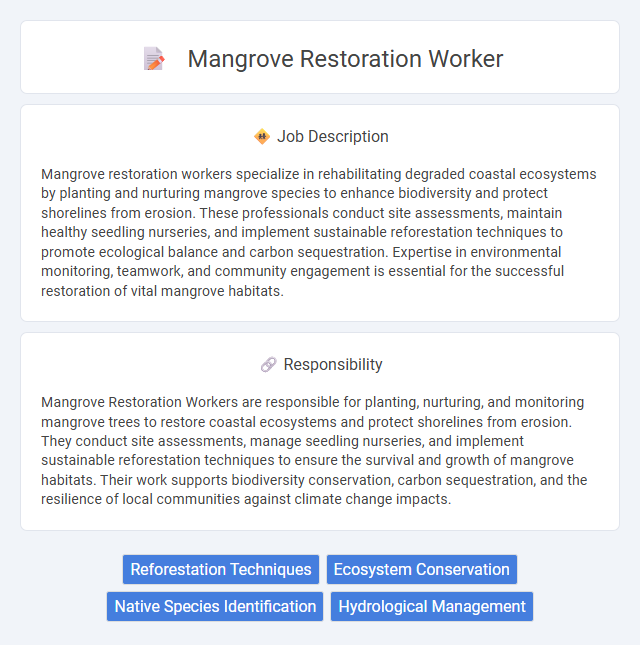
Mangrove restoration workers specialize in rehabilitating degraded coastal ecosystems by planting and nurturing mangrove species to enhance biodiversity and protect shorelines from erosion. These professionals conduct site assessments, maintain healthy seedling nurseries, and implement sustainable reforestation techniques to promote ecological balance and carbon sequestration. Expertise in environmental monitoring, teamwork, and community engagement is essential for the successful restoration of vital mangrove habitats.
Individuals who are physically fit and enjoy outdoor work in challenging environments are likely to be suitable for a Mangrove Restoration Worker role. Those comfortable with manual labor, working in wet and muddy conditions, and committed to environmental conservation may find this job fulfilling. Candidates who prefer sedentary work or struggle with physical endurance might find the position less appropriate for their skills and preferences.
Qualification
Mangrove Restoration Workers typically require a background in environmental science, biology, or ecology, often possessing a bachelor's degree or relevant field experience. Practical skills in plant identification, seedling transplantation, and habitat assessment are essential for effective restoration efforts. Physical fitness, ability to work in challenging coastal environments, and knowledge of local mangrove species and ecosystems enhance job performance.
Responsibility
Mangrove Restoration Workers are responsible for planting, nurturing, and monitoring mangrove trees to restore coastal ecosystems and protect shorelines from erosion. They conduct site assessments, manage seedling nurseries, and implement sustainable reforestation techniques to ensure the survival and growth of mangrove habitats. Their work supports biodiversity conservation, carbon sequestration, and the resilience of local communities against climate change impacts.
Benefit
A Mangrove Restoration Worker likely experiences significant benefits such as contributing to coastal ecosystem preservation, which may improve biodiversity and mitigate climate change effects. Engaging in this role possibly offers hands-on environmental stewardship, promoting personal fulfillment and community well-being. Opportunities for skill development in ecological restoration and teamwork could also be probable advantages.
Challenge
Mangrove restoration workers likely face significant challenges related to harsh environmental conditions, such as tidal fluctuations, extreme weather, and dense mangrove vegetation. The physical demands of planting and monitoring young mangroves in muddy, often inaccessible areas may increase the risk of injury and fatigue. Navigating these obstacles requires resilience and adaptability to ensure the successful regrowth of critical coastal ecosystems.
Career Advancement
Mangrove restoration workers gain specialized skills in environmental conservation and ecosystem rehabilitation, positioning themselves for roles such as project coordinators or environmental consultants. Mastery in techniques like seedling propagation, site assessment, and habitat monitoring enhances employability in NGOs and governmental agencies. Continuous training and involvement in large-scale restoration projects can accelerate career growth and leadership opportunities within the ecological restoration sector.
Key Terms
Reforestation Techniques
Mangrove restoration workers apply advanced reforestation techniques such as propagule planting, sediment stabilization, and hydrological restoration to rehabilitate degraded coastal ecosystems. Emphasis is placed on selecting native mangrove species, monitoring tidal flow, and employing adaptive management to enhance survival rates and biodiversity. These methods contribute significantly to carbon sequestration, shoreline protection, and habitat restoration for marine wildlife.
Ecosystem Conservation
Mangrove restoration workers play a crucial role in ecosystem conservation by rehabilitating coastal habitats that support biodiversity and protect shorelines from erosion. Their work involves planting mangrove saplings, monitoring growth, and maintaining the health of these vital forests to enhance carbon sequestration and improve marine life habitats. Restoration efforts contribute significantly to climate change mitigation and the preservation of fisheries that depend on mangrove ecosystems.
Native Species Identification
Mangrove restoration workers specialize in identifying native species such as Rhizophora, Avicennia, and Laguncularia to ensure the ecological integrity of coastal habitats. Accurate species identification supports the selection of appropriate planting sites and enhances the success of restoration efforts by promoting biodiversity. Expertise in native flora characteristics and habitat requirements is critical for monitoring ecosystem recovery and preventing invasive species encroachment.
Hydrological Management
Mangrove restoration workers specialize in hydrological management by monitoring tidal flows, water salinity, and sedimentation patterns to create optimal conditions for mangrove growth. They design and implement water control structures such as channels, dikes, and ponds to restore natural hydrology disrupted by human activities or climate change. Effective hydrological management enhances mangrove biodiversity, coastal protection, and carbon sequestration capacity.
 kuljobs.com
kuljobs.com